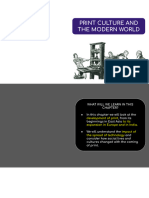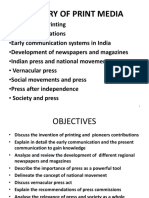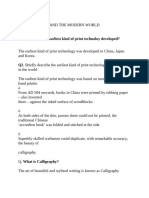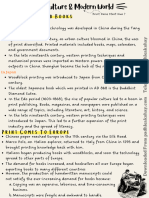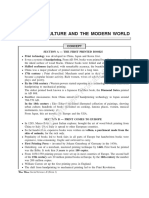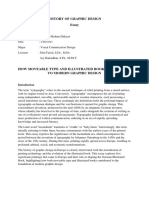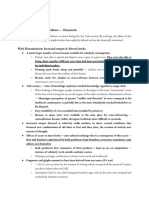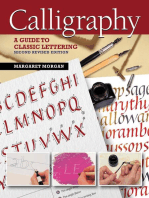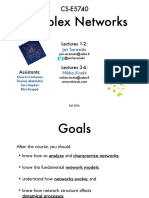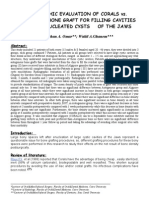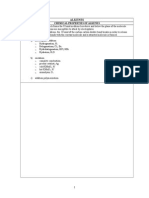0 ratings0% found this document useful (0 votes)
25 viewsPrinting Revolution: Prepared by Gautam Mukhopadhyay, Ramakrishna Mission Vidyamandira, Belur Math Howrah
Printing Revolution: Prepared by Gautam Mukhopadhyay, Ramakrishna Mission Vidyamandira, Belur Math Howrah
Uploaded by
Sreya MitraThe document discusses the history and development of printing in Europe. It summarizes that printing originated from earlier Chinese inventions of block printing and paper making. Johannes Gutenberg is widely credited with inventing the printing press in Mainz, Germany around 1450, though the technology was a social product, not the work of a single inventor. The printing press allowed for books and materials to be mass produced more cheaply using movable metal type, ink, and paper, fueling the Printing Revolution.
Copyright:
© All Rights Reserved
Available Formats
Download as PDF, TXT or read online from Scribd
Printing Revolution: Prepared by Gautam Mukhopadhyay, Ramakrishna Mission Vidyamandira, Belur Math Howrah
Printing Revolution: Prepared by Gautam Mukhopadhyay, Ramakrishna Mission Vidyamandira, Belur Math Howrah
Uploaded by
Sreya Mitra0 ratings0% found this document useful (0 votes)
25 views26 pagesThe document discusses the history and development of printing in Europe. It summarizes that printing originated from earlier Chinese inventions of block printing and paper making. Johannes Gutenberg is widely credited with inventing the printing press in Mainz, Germany around 1450, though the technology was a social product, not the work of a single inventor. The printing press allowed for books and materials to be mass produced more cheaply using movable metal type, ink, and paper, fueling the Printing Revolution.
Original Title
Untitled
Copyright
© © All Rights Reserved
Available Formats
PDF, TXT or read online from Scribd
Share this document
Did you find this document useful?
Is this content inappropriate?
The document discusses the history and development of printing in Europe. It summarizes that printing originated from earlier Chinese inventions of block printing and paper making. Johannes Gutenberg is widely credited with inventing the printing press in Mainz, Germany around 1450, though the technology was a social product, not the work of a single inventor. The printing press allowed for books and materials to be mass produced more cheaply using movable metal type, ink, and paper, fueling the Printing Revolution.
Copyright:
© All Rights Reserved
Available Formats
Download as PDF, TXT or read online from Scribd
Download as pdf or txt
0 ratings0% found this document useful (0 votes)
25 views26 pagesPrinting Revolution: Prepared by Gautam Mukhopadhyay, Ramakrishna Mission Vidyamandira, Belur Math Howrah
Printing Revolution: Prepared by Gautam Mukhopadhyay, Ramakrishna Mission Vidyamandira, Belur Math Howrah
Uploaded by
Sreya MitraThe document discusses the history and development of printing in Europe. It summarizes that printing originated from earlier Chinese inventions of block printing and paper making. Johannes Gutenberg is widely credited with inventing the printing press in Mainz, Germany around 1450, though the technology was a social product, not the work of a single inventor. The printing press allowed for books and materials to be mass produced more cheaply using movable metal type, ink, and paper, fueling the Printing Revolution.
Copyright:
© All Rights Reserved
Available Formats
Download as PDF, TXT or read online from Scribd
Download as pdf or txt
You are on page 1of 26
Printing Revolution
Prepared by Gautam Mukhopadhyay,
Ramakrishna Mission Vidyamandira, Belur
Math Howrah
Mainz (1450 AD)
• Three names recur in the sources – Johann
Gutenberg, Johann Fust and Peter Schoffer
• But it is impossible to determine accurately the
contribution of a particular individual to the
development of typography and its commercial
exploitation
• an invention in any case not the creation of an
individual, as is a poem or a painting, but a
social product
Prepared by Gautam Mukhopadhyay,
Ramakrishna Mission Vidyamandira, Belur
Math Howrah
Earlier beginnings
• Two Chinese inventions block printing
and paper, are linked with the beginnings
of typographic printing in Western
Europe
• Xylography, or block printing, originated
in China in the early 8th century
Prepared by Gautam Mukhopadhyay,
Ramakrishna Mission Vidyamandira, Belur
Math Howrah
Xylography or Block Printing
• The printer drew in reverse on a block of wood
the text or the picture he wished to reproduce,
carved the wood so that the graphic pattern
stood out in relief, inked the block, and
transferred the design to paper
Prepared by Gautam Mukhopadhyay,
Ramakrishna Mission Vidyamandira, Belur
Math Howrah
Its transmission to the West
• Probably during the century from 1250 to 1350, when
European contact with China was unusually close – had
little direct importance for the development of
typography.
• Its indirect importance, on the other hand, was great. It
probably suggested the next crucial step: cutting up and
old block into its constituent letters and then
rearranging these letters to spell out a new text. It
certainly diffused the idea of printing and of the printed
book
• While the lively commercial success staring in the late
14th century of printed playing cards (another Chinese
invention), religious prints, and crude block books
emphasized the magnitude of the market and the
potential profit to be got from it.
Prepared by Gautam Mukhopadhyay,
Ramakrishna Mission Vidyamandira, Belur
Math Howrah
Earlier Style of Writing
(Necessity of Paper)
• Paper was indispensable, but for economic rather than
technical reasons.
• Manuscript books were usually copied on parchment
(made from split sheep-skin) or on vellum (calf-skin),
and these materials were used also by typographic
printers when the aim was magnificence rather than
utility.
• But since a single large book like The Bible required as
many as 170 calf skins or 300 sheep skins, the absence
of paper soon would have nullified the promise of
mechanical duplication: the cheap, rapid production of
books in large numbers.
Prepared by Gautam Mukhopadhyay,
Ramakrishna Mission Vidyamandira, Belur
Math Howrah
Paper Manufacturing in Europe
• Paper manufacture was introduced in Spain
during the 12th century by the Arabs, who had
themselves received the technique from China.
• It spread slowly during the next two centuries
to much of Europe: Italy, France, Germany,
and Switzerland.
• By the time of Gutenberg’s youth, paper was
plentiful and sold for approximately one sixth
the price of parchment.
Prepared by Gautam Mukhopadhyay,
Ramakrishna Mission Vidyamandira, Belur
Math Howrah
• In Europe the chief raw material was old rags.
• Papermakers shredded the rags in a stamping
mill driven by water-power, mixed the
macerated flax and hemp fibers with water,
and dipped their mold, a large flat wire sieve
with a wooden frame, into the liquid pulp.
• When the pulp was evenly distributed over the
wire mesh and the water had run out through
the holes, they put the sheets on alternate
layers of felt, squeezed them in a press, and
then dried and sized them.
Prepared by Gautam Mukhopadhyay,
Ramakrishna Mission Vidyamandira, Belur
Math Howrah
Use of Ink in Europe
• Printing, as it was practiced in Mainz by
Gutenberg, Fust, and Schoffer, required a
suitable ink, a press for transferring the ink to
paper, and metal type.
• To adhere to metal smoothly and evenly, ink
must have an oil base.
• By the early 15th century, Flemish artists had
begun to print in oils; a suitable printer’s ink,
consisting of a pigment ground in a linseed-oil
varnish, was simply an adaptation of oil print.
Prepared by Gautam Mukhopadhyay,
Ramakrishna Mission Vidyamandira, Belur
Math Howrah
The invention of type
• The mirror image of each of the letters of the
alphabet made in metal by precision casting
from matrices.
Prepared by Gautam Mukhopadhyay,
Ramakrishna Mission Vidyamandira, Belur
Math Howrah
The skills which contributed to the development of
type casting were understandably those connected
with the more delicate forms of metallurgy: those of
the metal engraver and the designer of coins and
medals, of the goldsmith adept at casting small
objects, of craftsmen who made punches for stamping
letters on bells, pewter vessels, and book bindings.
Prepared by Gautam Mukhopadhyay,
Ramakrishna Mission Vidyamandira, Belur
Math Howrah
Many parallel efforts were made to
replace the scribe by a mechanical device;
that the actual invention of printing – a
‘dramatic fusion’ of familiar techniques into
a new and workable process – also occurred
independently in several places; that,
finally, this new process was perfected and
first organized as an industry by Gutenberg
and his contemporaries.
Prepared by Gautam Mukhopadhyay,
Ramakrishna Mission Vidyamandira, Belur
Math Howrah
Gutenberg Bible
• Gutenberg Bible also more cautiously named the
forty-two-line Bible by Bibliographers was finished in
1455.
• The craftsmanship of its type and the art of its type
setting and printing are impeccable.
Prepared by Gautam Mukhopadhyay,
Ramakrishna Mission Vidyamandira, Belur
Math Howrah
Prepared by Gautam Mukhopadhyay,
Ramakrishna Mission Vidyamandira, Belur
Math Howrah
Prepared by Gautam Mukhopadhyay,
Ramakrishna Mission Vidyamandira, Belur
Math Howrah
Fust and Schoffer’s Psalms
• On August 14, 1457, Fust and Schoffer issued the
Psalms.
• The volume was printed on vellum. The type, printed
in red and black, is noble and fits handsomely on the
page.
Prepared by Gautam Mukhopadhyay,
Ramakrishna Mission Vidyamandira, Belur
Math Howrah
• The lacy design of these letters, ornamented
with flowers and small, animals and printed in
red and blue, is masterly.
Prepared by Gautam Mukhopadhyay,
Ramakrishna Mission Vidyamandira, Belur
Math Howrah
• Each Psalm, as the printers boasted in a note at
the end, is “adorned with the beauty of large
initial letters”;
• Fust and Schoffer’s Psalms is the oldest signed
and dated book printed in Europe that has
survived. In its sober magnificence it is also
one of the most beautiful.
Prepared by Gautam Mukhopadhyay,
Ramakrishna Mission Vidyamandira, Belur
Math Howrah
• These first printed books have a further, and
curious, characteristic: their pages so closely
resemble those of manuscript books as to be
virtually indistinguishable to the unpracticed
eye.
• Clearly the printer’s technical, aesthetic, and
commercial aim was to reproduce exactly the
handwritten manuscripts.
Prepared by Gautam Mukhopadhyay,
Ramakrishna Mission Vidyamandira, Belur
Math Howrah
• The practice suggests rather that the earliest
printers had no conception of the unique
potentialities of their invention, that they
considered printing only a new and particular
kind of writing or the art of writing artificially
without reed or pen
• They thought that what they had to sell
consisted simply of less expensive manuscripts
in greater numbers
Prepared by Gautam Mukhopadhyay,
Ramakrishna Mission Vidyamandira, Belur
Math Howrah
Different types of printing
• Monasteries and cathedral chapters contracted for
the Latin Bibles, missals, Psalters, and
antiphonaries which were the printer’s most
important productions.
• The ecclesiastical authorities dominated job
printing; for example, a common order for
indulgence forms.
• The cheaper books, to judge from the earliest
publisher’s list, reflected traditional tastes;
biblical digests, works by St. Thomas Aquinas,
saint’s lives, brief guides to living well and dying
well, and for secular diversion, romances of
chivalry predominated.
Prepared by Gautam Mukhopadhyay,
Ramakrishna Mission Vidyamandira, Belur
Math Howrah
Rapid spread of printing
(1460 – 1500)
• Demand for books among the merchants, substantial
artisans, lawyers, government officials, doctors, and the
teachers who lived and worked in towns.
• Printing spread from Mainz to Strasbourg, Cologne,
Augsburg, Nuremberg, Leipzig, and Vienna.
• German printers, or their pupils, introduced the ‘divine’
art to Italy in 1467, Switzerland and Bohemia in 1468,
France and the Netherlands in 1470. Spain, England,
Hungary, and Poland between 1474 and 1476, Denmark
and Sweden in 1482-83.
• By 1500 the presses had issued about six million books in
approximately forty thousand editions, more books,
probably, than had been produced in Western Europe
since the fall of Rome.
Prepared by Gautam Mukhopadhyay,
Ramakrishna Mission Vidyamandira, Belur
Math Howrah
Results
1. Removal of inaccuracy and unreliability
• The fundamental contribution of printing to learning is
that it halted this progressive corruption and made
possible the long and continuing effort to restore the great
texts of the past to something approaching their original
integrity.
• Printing gave scholars all over Europe identical texts to
work on. Referring precisely to a particular word in a
particular line on a particular page, a scholar in Basel
could propose an emendation which could be rapidly
checked by his colleagues in Rome or Florence.
• Comparison between two texts became easier now.
Prepared by Gautam Mukhopadhyay,
Ramakrishna Mission Vidyamandira, Belur
Math Howrah
2. Changing mode of intellectual works
• Printing turned intellectual work as a whole into a
cooperative instead of a solitary human activity.
• Printing enlarged the amount of intellectual effort
applied to individual problems.
• Scientific research – and all scholarship –
became, through this new tool of the intellect, a
public dialogue, a published exchange of novel
results controlled by cooperative critical
examination and the repetition of experiments.
Example: Copernicus’ Theory and its publication
Prepared by Gautam Mukhopadhyay,
Ramakrishna Mission Vidyamandira, Belur
Math Howrah
3. Increasing availability of books
• Printing not only made scholarship fuller and
more accurate; it also made it less difficult to
acquire.
• Because of the greater standardization of print,
learning to read was easier.
• Now individuals could afford to own books,
where before they had normally been owned
almost exclusively by institutions –
monasteries, cathedral chapters, and colleges.
Prepared by Gautam Mukhopadhyay,
Ramakrishna Mission Vidyamandira, Belur
Math Howrah
4. End of the age of the walking encyclopedia
• Medieval students had to compile their own
dictionaries and reference books, and much of
their time in the lecture room was spent writing
out texts dictated by the teacher.
• Now the student could read the text at home. To
learn had been to memorize; printing freed the
memory.
• For Michel de Montaigne, the French essayist, the
walking encyclopedia was a pedant; but he could
legitimately brand him pedant only because
printed reference books now served the traditional
function of the human memory.
Prepared by Gautam Mukhopadhyay,
Ramakrishna Mission Vidyamandira, Belur
Math Howrah
You might also like
- New Haven Area Downsizing Donation GuideDocument56 pagesNew Haven Area Downsizing Donation GuideNHUDL100% (1)
- Theory and Application of Statistical Energy AnalysisDocument292 pagesTheory and Application of Statistical Energy AnalysisyoosefNo ratings yet
- Christina Torres-Rouff Tesis Doctoral Deformacion Craneal PDFDocument229 pagesChristina Torres-Rouff Tesis Doctoral Deformacion Craneal PDFRCEBNo ratings yet
- Print Culture & The Modern World (YT)Document147 pagesPrint Culture & The Modern World (YT)Parvinder KaurNo ratings yet
- Print Culture and The Modern World FULL CHAPTERDocument130 pagesPrint Culture and The Modern World FULL CHAPTERAnsul PrakashNo ratings yet
- Print Culture - The Modern World L - 1Document63 pagesPrint Culture - The Modern World L - 1dark aaasNo ratings yet
- Print Culture and The Modern World - Short Notes - by @PWD - BDocument4 pagesPrint Culture and The Modern World - Short Notes - by @PWD - BLokesh YadavNo ratings yet
- Print Culture & The Modern World L - 1Document70 pagesPrint Culture & The Modern World L - 1aaliyamyid7No ratings yet
- Print Culture Part 1-4Document16 pagesPrint Culture Part 1-4amulyajadhav119No ratings yet
- PRINT CULTURE AMD THE MODERN WORLDDocument4 pagesPRINT CULTURE AMD THE MODERN WORLDPranjal MehtaniNo ratings yet
- Print Culture NotesDocument8 pagesPrint Culture Notestopgun22069No ratings yet
- HistoryofprintmediaDocument65 pagesHistoryofprintmediaYagnikPatelNo ratings yet
- History of Print MediaDocument65 pagesHistory of Print MediaRounak Basu100% (1)
- History of Print MediaDocument65 pagesHistory of Print MediaRounak Basu100% (1)
- Print Culture Ppt 1Document78 pagesPrint Culture Ppt 1tpmsomrolc.dhanasreek6dNo ratings yet
- Chapter - 5 Print - Culture - and - The - Modern - WorldDocument19 pagesChapter - 5 Print - Culture - and - The - Modern - Worldhimanshu854592No ratings yet
- Print Culture and Modern WorldDocument46 pagesPrint Culture and Modern Worldraiyarthsingh1No ratings yet
- PrintDocument23 pagesPrintrasopal376No ratings yet
- Print Culture NOTES-1Document16 pagesPrint Culture NOTES-1dekshinthanoopNo ratings yet
- Print Culture NotesDocument19 pagesPrint Culture NotesAsmithaNo ratings yet
- Class10 History Print Culture and Morden WorldDocument17 pagesClass10 History Print Culture and Morden WorldPratima KaushalNo ratings yet
- Print, Culture and The Modern WorldDocument19 pagesPrint, Culture and The Modern WorldAtampreet KaurNo ratings yet
- (CH-7 HISTORY GRADE-X)Document74 pages(CH-7 HISTORY GRADE-X)Sheetal SharmaNo ratings yet
- CBSE G+10 Print+Culture+and+the+Modern+World NotesDocument6 pagesCBSE G+10 Print+Culture+and+the+Modern+World Notesazhagudurairathika3No ratings yet
- Print Culture and the Modern WorldDocument24 pagesPrint Culture and the Modern Worldabhiniveshsriram7No ratings yet
- Print Culture & The Modern World-1Document38 pagesPrint Culture & The Modern World-1Naisha ManglaNo ratings yet
- Print Culture and The Modern World 10 - WatermarkDocument27 pagesPrint Culture and The Modern World 10 - WatermarkSimranpreet horaNo ratings yet
- Print Culture and The Modern WorldDocument13 pagesPrint Culture and The Modern WorldSuvali ShettyNo ratings yet
- STS Printing PressDocument11 pagesSTS Printing PressLeila ValerioNo ratings yet
- Class 10th SST Notes Part 2Document3 pagesClass 10th SST Notes Part 2king124421kgNo ratings yet
- SWATI ARORA- Print Culture and the Modern WorldDocument15 pagesSWATI ARORA- Print Culture and the Modern Worldcustomer9531No ratings yet
- PrintDocument36 pagesPrintraiyarthsingh1No ratings yet
- Print Culture and Modern World - HistoryDocument6 pagesPrint Culture and Modern World - HistoryYashaswi GargNo ratings yet
- Print Culture and Modern WorldDocument8 pagesPrint Culture and Modern Worldharmanjotsinghh20No ratings yet
- Print CultureDocument18 pagesPrint CultureSheetal SharmaNo ratings yet
- Hist-C6 Rise of The Modern West-I: Course Instructor Dr. Oyndrila SarkarDocument12 pagesHist-C6 Rise of The Modern West-I: Course Instructor Dr. Oyndrila Sarkarabhaskrsahaeb100yrsNo ratings yet
- Print CultureDocument21 pagesPrint CultureMubrraNo ratings yet
- PRINT CULTURE CLASS 10 (1)Document14 pagesPRINT CULTURE CLASS 10 (1)nikhileshsundar06No ratings yet
- Print Culture NotesDocument32 pagesPrint Culture NotesApkNo ratings yet
- Print Coulture-x PptxDocument74 pagesPrint Coulture-x Pptxanandakrishnanj7No ratings yet
- Print, Culture and The Modern WorldDocument15 pagesPrint, Culture and The Modern Worldjuanmohammed3201No ratings yet
- History Class X Chapter 7Document24 pagesHistory Class X Chapter 7Ashish KumarNo ratings yet
- Print Culture and The Modern WorldDocument73 pagesPrint Culture and The Modern WorldSimmi Grover100% (1)
- MRP Report BABU CHERIAN PDFDocument50 pagesMRP Report BABU CHERIAN PDFAnjali Krishnan.p. kNo ratings yet
- Print 1Document34 pagesPrint 1x.y.z.sweta3No ratings yet
- 7.print CultureDocument7 pages7.print Cultureshalini 13No ratings yet
- Print Culture and Mosern World Part 5-9Document16 pagesPrint Culture and Mosern World Part 5-9amulyajadhav119No ratings yet
- Print Culture and The Modern World (Prashant Kirad)Document12 pagesPrint Culture and The Modern World (Prashant Kirad)comebacksoon3639100% (13)
- Print Culture and The Modern WorldDocument7 pagesPrint Culture and The Modern Worlddharap0311No ratings yet
- How Moveable Type and Illustrated Book Contributes To Modern Graphic DesignDocument8 pagesHow Moveable Type and Illustrated Book Contributes To Modern Graphic Designc.reihan.hNo ratings yet
- Our Own High School, Al Warqa'a, Dubai Print Culture and The Modern World Grade 10 2020-2021Document18 pagesOur Own High School, Al Warqa'a, Dubai Print Culture and The Modern World Grade 10 2020-2021mashood azadNo ratings yet
- Print CultureDocument5 pagesPrint CultureRhea JohnNo ratings yet
- Book HistoryDocument6 pagesBook HistoryAnia SiminskaNo ratings yet
- Class 10 Print Culture and The Modern World - Part - I NotesDocument9 pagesClass 10 Print Culture and The Modern World - Part - I Noteshamsinimurali20No ratings yet
- Print Culture and The Modern WorldDocument5 pagesPrint Culture and The Modern Worldspecialiam541No ratings yet
- Social Science Class X Print CultureDocument30 pagesSocial Science Class X Print CultureDilip DhaliNo ratings yet
- Unit 1 Some Features of Print Culture - Eisenstein: Wide Dissemination: Increased Output & Altered IntakeDocument44 pagesUnit 1 Some Features of Print Culture - Eisenstein: Wide Dissemination: Increased Output & Altered IntakecrytittybabyNo ratings yet
- 5 Print Culture and The Modern WorldDocument13 pages5 Print Culture and The Modern Worldbobby2u001No ratings yet
- The Print CultureDocument26 pagesThe Print CultureSheetal SharmaNo ratings yet
- Print Culture and The Modern World: AD 768-770: Buddhist Missionaries From China Introduced Hand-PrintingDocument6 pagesPrint Culture and The Modern World: AD 768-770: Buddhist Missionaries From China Introduced Hand-PrintingdonNo ratings yet
- Print Culture and The Modern World: AD 768-770: Buddhist Missionaries From China Introduced Hand-PrintingDocument6 pagesPrint Culture and The Modern World: AD 768-770: Buddhist Missionaries From China Introduced Hand-PrintingSaumya Saumya100% (1)
- Calligraphy, Second Revised Edition: A Guide to Classic LetteringFrom EverandCalligraphy, Second Revised Edition: A Guide to Classic LetteringRating: 5 out of 5 stars5/5 (1)
- CN 2016 Lecture1Document46 pagesCN 2016 Lecture1Dr HussainNo ratings yet
- RM400 Wear Part TrainingDocument18 pagesRM400 Wear Part TrainingMp pmNo ratings yet
- C73x-X73x-C74x-X74x PS FRUs Module Rev1.0Document8 pagesC73x-X73x-C74x-X74x PS FRUs Module Rev1.0Pedro MachadoNo ratings yet
- Price List W.E.F 1 June 2021: Authorized Channel PartnerDocument49 pagesPrice List W.E.F 1 June 2021: Authorized Channel Partnerkarthik achudhanNo ratings yet
- Journal-List PortugalDocument58 pagesJournal-List PortugalJoseNo ratings yet
- Management of Moderate Acute Malnutrition: When To Start ProgrammesDocument5 pagesManagement of Moderate Acute Malnutrition: When To Start Programmesmadiha altafNo ratings yet
- Occurrence of Hormonally Active Compounds in Food A ReviewDocument27 pagesOccurrence of Hormonally Active Compounds in Food A ReviewJose Antonio VenacostaNo ratings yet
- Baguio City HeritageDocument16 pagesBaguio City HeritageDerrick Yson (Mangga Han)No ratings yet
- Townsley, P., 1998. Social Issues in FisheriesDocument94 pagesTownsley, P., 1998. Social Issues in FisheriesRafi DarojatNo ratings yet
- Sunday Morning: by Wallace StevensDocument4 pagesSunday Morning: by Wallace StevensMarinela CojocariuNo ratings yet
- 1 Confined SpaceDocument29 pages1 Confined Spacesalman ahmadNo ratings yet
- Sunnen Alusil Honing TechDocument7 pagesSunnen Alusil Honing TechEdidjo Darwin50% (2)
- Final PaperDocument12 pagesFinal PaperKhaled Atef ElhayesNo ratings yet
- WM-SD - Cross Docking FunctionalityDocument3 pagesWM-SD - Cross Docking FunctionalityDrcytoNo ratings yet
- Seminor Report Front PagesDocument4 pagesSeminor Report Front PagesDiwakar DiwakarNo ratings yet
- Evolution of Thermally Induced White Etching Layer at Rail Surface During Multiple Wheel - Train PassagesDocument13 pagesEvolution of Thermally Induced White Etching Layer at Rail Surface During Multiple Wheel - Train Passagesanime MAVCNo ratings yet
- MTW Owner's ManualDocument18 pagesMTW Owner's ManualrhokahinNo ratings yet
- Manual de Venta de PiezasDocument378 pagesManual de Venta de PiezasGARY BAUTISTANo ratings yet
- Kraton D Polymer: The Cost Effective Modifier in Asphalt Road PavingDocument4 pagesKraton D Polymer: The Cost Effective Modifier in Asphalt Road PavingYousef AlipourNo ratings yet
- Spiritual Conflict - Volume 3: God's People TriumphantDocument7 pagesSpiritual Conflict - Volume 3: God's People TriumphantBruce Mulenga SimpasaNo ratings yet
- F.A.L. Conducive Engineering Review Center: 2 Floor, Cartimar Building, C.M. Recto Avenue, Sampaloc, ManilaDocument2 pagesF.A.L. Conducive Engineering Review Center: 2 Floor, Cartimar Building, C.M. Recto Avenue, Sampaloc, ManilaELMERNo ratings yet
- Institute Letter Fall 2022 3 - 0Document31 pagesInstitute Letter Fall 2022 3 - 0Anonno DipNo ratings yet
- Evaluation of Damping in Dynamic Analysis of StructuresDocument4 pagesEvaluation of Damping in Dynamic Analysis of StructuresMarian PopescuNo ratings yet
- Guide To Drawer Slides, A Pain-Free Slide InstallationDocument4 pagesGuide To Drawer Slides, A Pain-Free Slide InstallationRazvan Pascaniuc100% (1)
- A Collection of Miscellaneous Rifts Magic ItemsDocument6 pagesA Collection of Miscellaneous Rifts Magic ItemsyrtalienNo ratings yet
- Chemical Properties of Alkenes (Q Only)Document15 pagesChemical Properties of Alkenes (Q Only)mawarhanifNo ratings yet
- Condition Monitoring System Based On Effects of Electrical Torque Pulsations of Wind Turbine GeneratorsDocument6 pagesCondition Monitoring System Based On Effects of Electrical Torque Pulsations of Wind Turbine GeneratorsKhaled AbdusamadNo ratings yet



